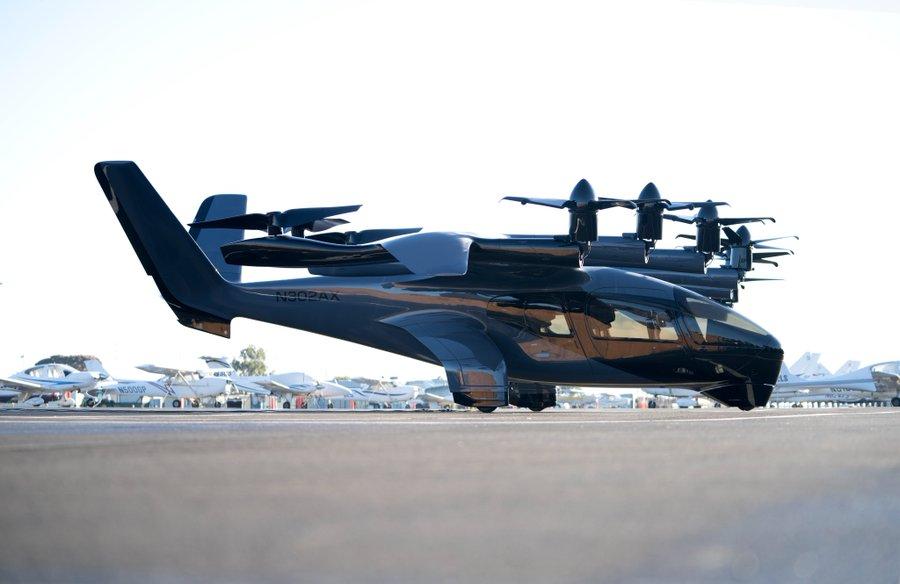
Midnight eVTOL.
It’s often been observed by AAM industry watchers that eVTOL production will be like aerospace manufacturing at automotive scale.
Many of the leading companies in both sectors seem to agree. The recent announcement that Stellantis will serve as the exclusive contract manufacturer to mass produce Archer Aviation’s Midnight air taxi is just the latest example of collaboration between automotive and electric vertical takeoff and landing (eVTOL) companies. Toyota has been a strategic partner and investor in Joby Aviation since 2020, and Supernal is a unit of Hyundai Motor Group. Against that backdrop, it would hardly be surprising to see additional cross-industry collaborations announced in the coming months as the race to commercialization heats up.
Echoing that view, Raymond James analyst Savanthi Syth wrote in a recent client note that she views extensive partnerships between eVTOL startups and experienced automobile manufacturers as “competitive advantages” for the companies involved, and noted the substantial synergies between the two industries.
“EVTOLs are designed for mass manufacturing, with manufacturing processes more akin to high-volume auto manufacturers than airplanes due to fewer parts and less complexity,” she wrote in a report following the Archer-Stellantis announcement. “Auto manufacturers are able to contribute best practices for plant layout, design, production efficiencies and battery procurement, among other learnings.”
Sergio Cecutta, founder and partner at SMG Consulting, said he agrees about the synergies between automotive and eVTOL, but cautioned against making direct comparisons between the two industries of vastly different scale. “Even the tiniest automotive company is still two-four times as big as you’d likely find in eVTOL,” he says.
Besides providing much-needed capital, automobile manufacturers also have access to something else that eVTOL startups need perhaps even more: high-performance batteries–and lots of them. “As much as we like to say that our batteries are special, really we make almost no batteries,” Cecutta says of the eVTOL sector. “I mean, even 2,000 airplanes with all of our batteries pale in comparison next to the millions of electric vehicles being made each year.”
Not all analysts are as enamored with the cross-industry collaboration, however. Bill Johnson, founder of Single Seat Consulting, says he is skeptical that automobile companies truly have the understanding of what it takes to operate in the highly regulated aviation manufacturing space, where critical systems and components must be certified by the FAA at a one-in-a-billion probability of failure–an exponentially higher safety bar than for automobiles.
“My view is that the automotive industry certainly has the understanding of scale, but they do not understand the safety and specifications that you need for aviation,” Johnson says. “The difference between them is the amount of tolerance that you have for safety. A car’s engine or systems can fail and it’s not necessarily an emergency, but in a plane that’s not the case."
“Basically, the culture and mentality of the mass production of automobiles does not inculcate this idea of very precise and safety consciousness that the aviation industry requires,” Johnson adds. “These partnerships will probably still offer an advantage, but it’s incremental, and I think other companies could get the same expertise through other means.”
Cecutta, meanwhile, said he does agree with the assessment about the gulf in safety between automotive and aviation. “With automotives, quality is a customer satisfaction point; in aerospace, quality is a certification issue,” he notes. “If you aren’t making perfect copies of your certified aircraft, the FAA is not going to let you keep making airplanes.”
But in the case of Archer, at least, he thinks there is real value in having an experienced mass-producer of automobiles take over manufacturing duties on behalf of the startup.
“Stellantis is going to become the contract manufacturer for Archer, so it’s a little bit like the relationship with Apple and Foxconn,” Cecutta says. “That means a significant, positive impact on the balance sheet of Archer because they don’t have to carry all the CapEx [capital expenditures] associated with mass production. That frees up a lot of cash to go into R&D and developing new versions—and it makes them a more attractive company.”





